How to Taste Wine Like an Expert
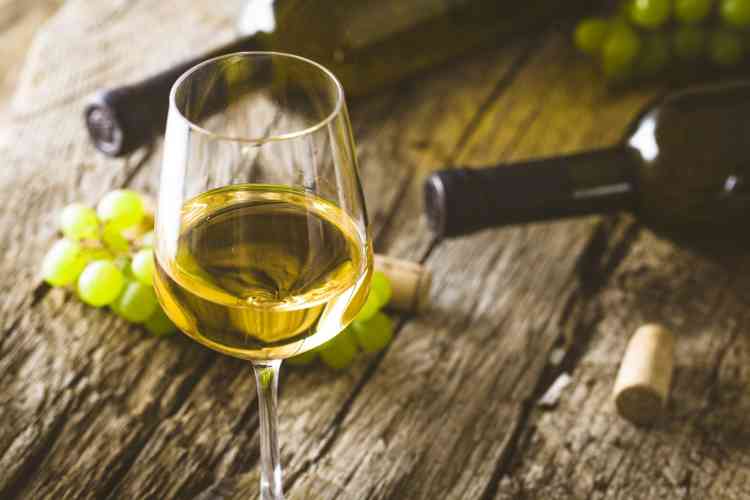
Learning how to taste wine like an expert takes practice, but with a few simple pointers you’ll be well on your way to swirling, sniffing and sipping like a professional wine taster.
How do you judge wine by taste, or smell or sight? Once you learn how to taste wine, the stress of picking out the perfect bottle evaporates. You’ll know exactly what tasting notes you enjoy and will have confidence in your wine selections, whether you’re shopping for yourself, a party or a gift.
Follow the wine tasting tips below to develop your palate and learn how to describe wine like a pro.
Jump to Section
- Learn How to Taste Wine With the Experts
- How to Taste Wine
- Wine Tasting Step 1: Evaluate by Sight
- Wine Tasting Step 2: Evaluate by Smell
- Wine Tasting Step 3: Evaluate by Taste
Learn How to Taste Wine With the Experts
If you’d like to learn how to taste wine from industry-renowned experts without leaving your home, virtual wine tastings are the perfect solution.
Each virtual tasting is led by a world-class chef or sommelier who offers insight into the wine tasting process, gourmet food and wine pairings, and more. You’ll learn everything you need to know about how to taste wine like a professional right from the comfort of home.
To get started on your own, there are some trusted rules of thumb that can help you on your way.

How to Taste Wine
Tasting wine is about more than savoring the wine’s flavor; wine tasting also engages your senses of sight and smell. To learn how to taste wine like a sommelier, simply follow your senses of sight, smell and finally, taste.
First, take note of the visual qualities of the wine, then gently swirl and sniff your glass to take in the aroma. Finally, put your palate to work and identify different flavors evident in the wine.
Wine Tasting Step 1: Evaluate by Sight
The first step in how to taste wine is to evaluate the wine by sight. After pouring your glass of wine, take a moment to evaluate how the wine looks. The color and opacity of different types of wine can hint at the age of the wine and the acidity, alcohol and sugar content.
Tilt your glass to the side so you see the wine’s color range. What is the color of the wine? Is it ruby red, or more purple? Is it deep gold, or more pale yellow? White wines tend to deepen in color and become more opaque as they age. Red wines become more transparent as they age. As you learn how to taste wine, you’ll notice the wide variety of colors wines can be and the different flavors they impart.
Evaluating the “legs” in your glass when you learn how to taste wine is a simple way to determine the sugar and alcohol content. Give your glass a swirl and watch the drips left on the sides of the glass as the wine settles — these are the “wine legs.” The thicker and more viscous the legs, the more alcohol or residual sugar is in the wine.
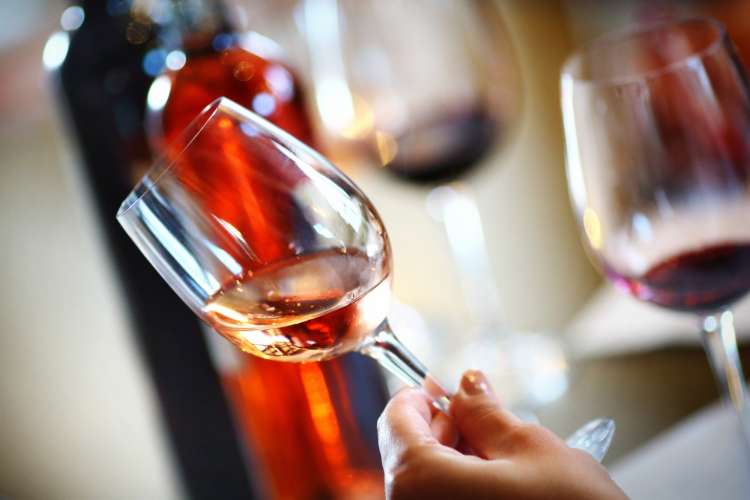
Wine Tasting Step 2: Evaluate by Smell
After evaluating how the wine looks, it’s time to evaluate the wine’s aroma. The second part to learning how to taste wine is evaluating by smell. Give your wine glass a swirl and breathe in deeply through your nose at the top of the wine glass. Don’t forget to swirl the wine because the act of swirling increases the aroma compounds that are released into the air. To get past the “wine smell,” alternate between long sniffs and short sniffs.
Part of learning how to taste wine is learning how to describe wine. As you sniff, it’s helpful to think of aromas from large to small. For example, are there citrus scents or berry scents? Once you’ve established a dominant smell, you can move on to notes like oak or fennel. You are smelling for three kinds of aromas: primary, secondary and tertiary.
Primary Aromas
Primary aromas come from the type of grape and climate in which it grows. Fruit flavors in wine are typically primary aromas, as well as floral and herbal aromas.
For white wines, think citrus fruits (orange, lemon), orchard fruits (like apple) or tropical fruits (like mango or melon). For red wines, think red fruits (raspberry, strawberry), black fruits (blackberry, black plum) and blue fruits, like blueberry. Other aromas you may notice are herbal aromas like mint or floral aromas like lavender.
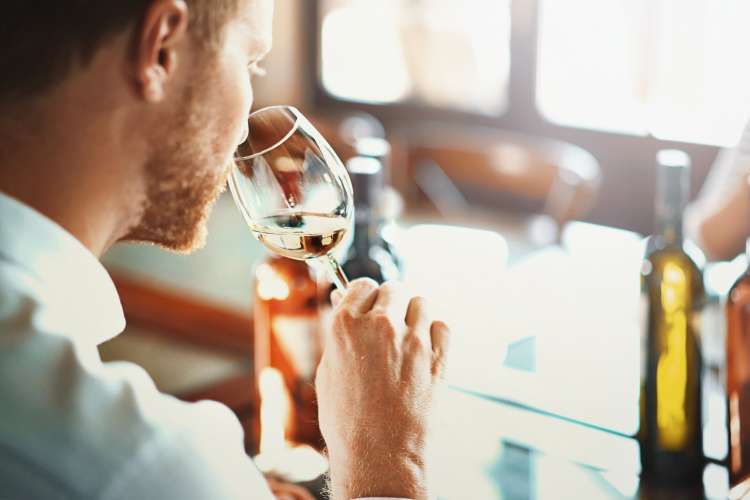
Secondary Aromas
Secondary aromas come from the wine’s fermentation process. When you learn how to taste wine, you’ll note these aromas can be sharp, distinct and often yeasty (like sourdough bread). These aromas should not be too sharp, as that could indicate a spoiled wine. Some examples of secondary aromas are buttermilk, mushroom or beer-like aromas.
Tertiary Aromas
Tertiary aromas come from wine’s aging process. These aromas often appear as caramel or vanilla flavors deriving from the oak barrels used to age the wine. When a bit of oxygen permeates the wine through the barrel, nuttiness is introduced to the wine. The oak barrel itself imparts vanilla or caramel flavors into the wine similar to how tea leaves impart flavor in hot water.
Some more tertiary aromas you may notice are spices like cinnamon or deep flavors like roasted almond or caramelized sugar. As you become more practiced at knowing how to taste wine, your ability to identify tertiary aromas will increase.
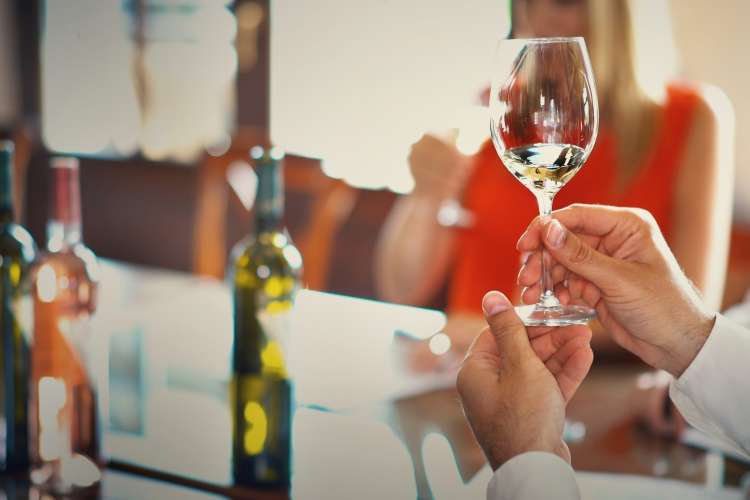
Wine Tasting Step 3: Evaluate by Taste
After you’ve evaluated the look and smell of your wine, it’s finally time to take a sip! The final step to learning how to taste wine is to actually taste it. As you enjoy each tasting or wine flight selection, let it circulate throughout your mouth. What does the wine taste like? As the wine circulates, take note of the feel of the wine in your mouth and the sensations it creates on your tongue. Is the wine balanced? Is it complex? What is the finish of the wine?
Balance
A balanced wine will have its flavors in good proportion. It should not taste too sweet nor too sour nor too bitter.
Sweetness is most acute the first moment you taste a wine, and you’ll taste it on the tip of your tongue. Acidity, or how sour a wine tastes, creates a mouthwatering sensation in the back of your jaw. With red wines, you will also perceive tannins. Tannins create a cotton-ball-like drying sensation in your mouth.
A good wine will have all of these flavors in harmony; although you may notice each note, one will not stand out much more than the other. In a good wine, this harmony increases with age. As you learn how to taste wine, your experiences with good and poor quality wines will help you distinguish which wines have harmony and which do not.
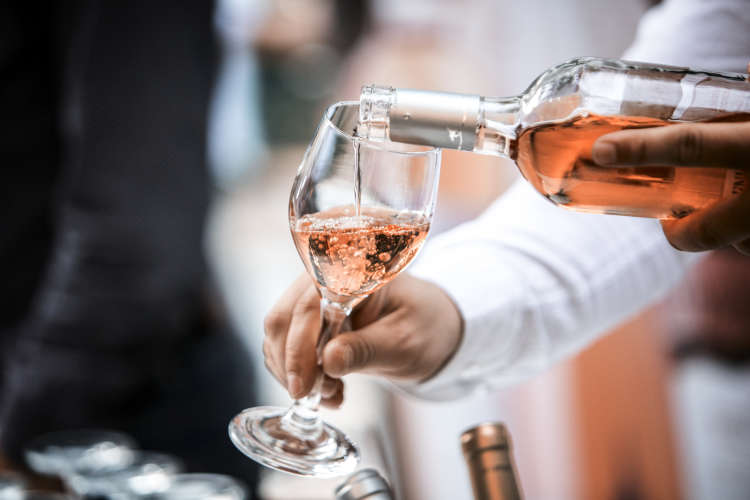
Complexity
Complex wines have layers of flavor that develop as the wine rests on your tongue. When you’re first learning how to taste wine, it’s tempting to move on quickly to the next sip. But when tasting a good wine, take a moment to let the flavor of your first sip sit. Take in the different flavors and sensations the wine creates as it sits. How does the wine change as you taste it? Older wines and higher quality wines tend to have more complexity.
Finish
The quality of a wine is also determined by its finish, or how long the flavor lingers in your mouth after a sip and the feel of the wine in your mouth. How long did the flavor linger in your mouth? What is the body of the wine — did it feel light, like water, or almost creamy? If the complex flavor of the wine stays for a while after your first sip, it’s likely a high quality wine. In a lower quality wine, the flavor will dissipate quickly.
Length
The length of a wine is how long the flavor lingers after you swallow. A wine with a longer length likely has good complexity. After you take your first swallow of wine, you may consider setting a timer to see how long the flavor lasts. In a tasting environment where you’re learning how to taste wine, this could help you differentiate between varieties that may taste good but are of differing quality.
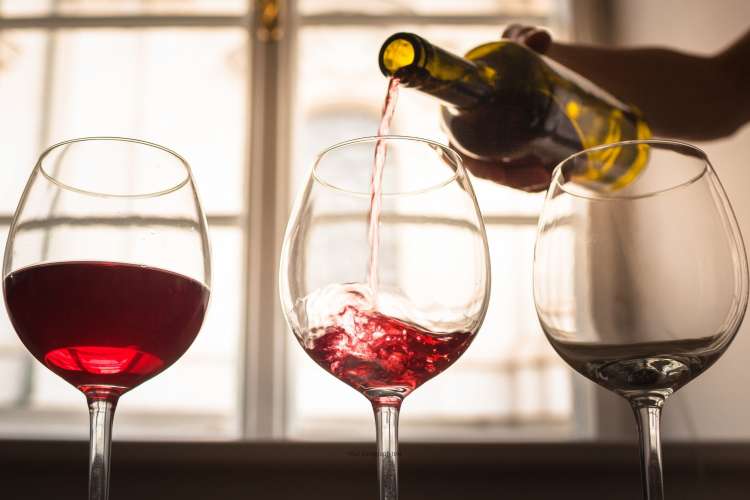
After swirling, sniffing and sipping, take a moment to jot down your thoughts on the wine. After all, the goal of learning how to taste wine properly is to discover what wines you enjoy. Taking a few wine tasting notes can help you remember what qualities you enjoy, narrowing down your decision next time you’re at dinner or the grocery store. Once you’ve learned how to taste wine, you’ll be able to pick an enjoyable bottle with ease.
For even more insight into gourmet wine tastings, check out other experiences happening on Cozymeal.




FOOD FOR THOUGHT?
Join the conversation.